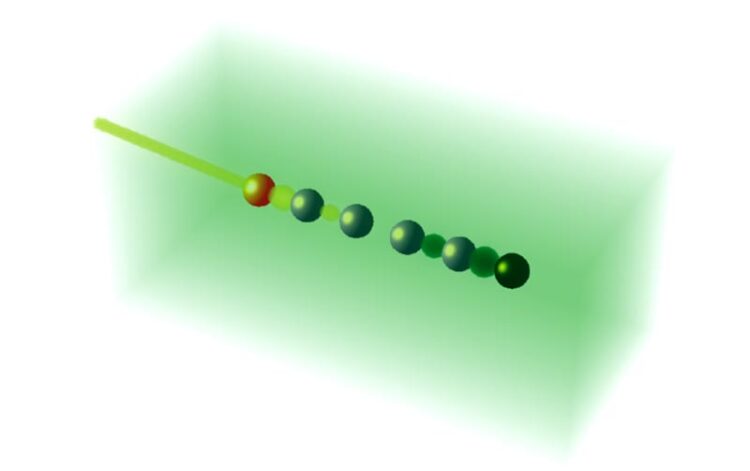Physicists exploit space and time symmetries to control quantum materials

Quantum transport in a chain of resonators obeying space reflection and time reversal symmetries.
Credit: Vasil Saroka
Physicists from Exeter and Trondheim have developed a theory describing how space reflection and time reversal symmetries can be exploited, allowing for greater control of transport and correlations within quantum materials.
Two theoretical physicists, from the University of Exeter (United Kingdom) and the Norwegian University of Science and Technology (in Trondheim, Norway), have built a quantum theory describing a chain of quantum resonators satisfying space reflection and time reversal symmetries. They have shown how the different quantum phases of such chains are associated with remarkable phenomena, which may be useful in the design of future quantum devices relying on strong correlations.
A common distinction in physics is between open and closed systems. Closed systems are isolated from any external environment, such that energy is conserved because there is nowhere for it to escape to. Open systems are connected to the outer world, and via exchanges with the environment they are subject to energy gains and energy losses. There is an important third case. When the energy flowing in and flowing out of the system is finely balanced, an intermediate situation between being open and closed arises. This equilibrium can occur when the system obeys a combined symmetry of space and time, that is when (1) switching left and right and (2) flipping the arrow of time leave the system essentially unchanged.
In their latest research, Downing and Saroka discuss the phases of a quantum chain of resonators satisfying space reflection and time reversal symmetries. There are principally two phases of interest, a trivial phase (accompanied by intuitive physics) and a nontrivial phase (marked with surprising physics). The border between these two phases is marked by an exceptional point. The researchers have found the locations of these exceptional points for a chain with an arbitrary number of resonators, providing insight into the scaling up of quantum systems obeying these symmetries. Importantly, the nontrivial phase allows for unconventional transport effects and strong quantum correlations, which may be used to control the behaviour and propagation of light at nanoscopic length scales.
This theoretical study may be useful for the generation, manipulation and control of light in low-dimensional quantum materials, with a view to building light-based devices exploiting photons, the particles of light, as workhorses down at sizes around one billionth of a meter.
Charles Downing, from the University of Exeter, commented: “Our work on parity-time symmetry in open quantum systems further emphasises how symmetry underpins our understanding of the physical world, and how we may benefit from it”.
Vasil Saroka, from the Norwegian University of Science and Technology, added: “We hope that our theoretical work on parity-time symmetry can inspire further experimental research in this exciting area of physics”.
“Exceptional points in oligomer chains” is published in Communications Physics, an open access journal from the Nature Portfolio.
Journal: Communications Physics
DOI: 10.1038/s42005-021-00757-3
Article Title: Exceptional points in oligomer chains
Article Publication Date: 2-Dec-2021
Media Contact
Louise Vennells
University of Exeter
pressoffice@exeter.ac.uk
Office: 0044-139-272-2062
All latest news from the category: Physics and Astronomy
This area deals with the fundamental laws and building blocks of nature and how they interact, the properties and the behavior of matter, and research into space and time and their structures.
innovations-report provides in-depth reports and articles on subjects such as astrophysics, laser technologies, nuclear, quantum, particle and solid-state physics, nanotechnologies, planetary research and findings (Mars, Venus) and developments related to the Hubble Telescope.
Newest articles

Innovative 3D printed scaffolds offer new hope for bone healing
Researchers at the Institute for Bioengineering of Catalonia have developed novel 3D printed PLA-CaP scaffolds that promote blood vessel formation, ensuring better healing and regeneration of bone tissue. Bone is…

The surprising role of gut infection in Alzheimer’s disease
ASU- and Banner Alzheimer’s Institute-led study implicates link between a common virus and the disease, which travels from the gut to the brain and may be a target for antiviral…

Molecular gardening: New enzymes discovered for protein modification pruning
How deubiquitinases USP53 and USP54 cleave long polyubiquitin chains and how the former is linked to liver disease in children. Deubiquitinases (DUBs) are enzymes used by cells to trim protein…


